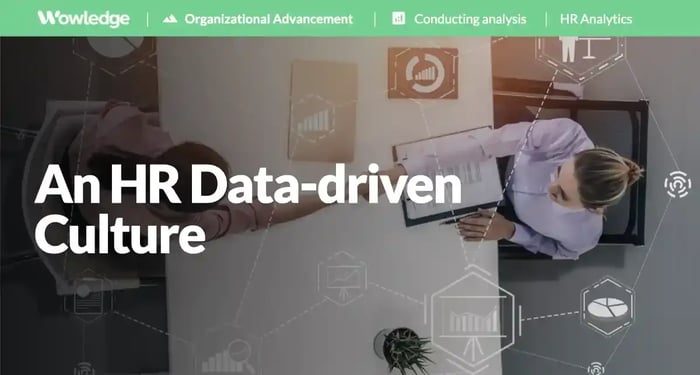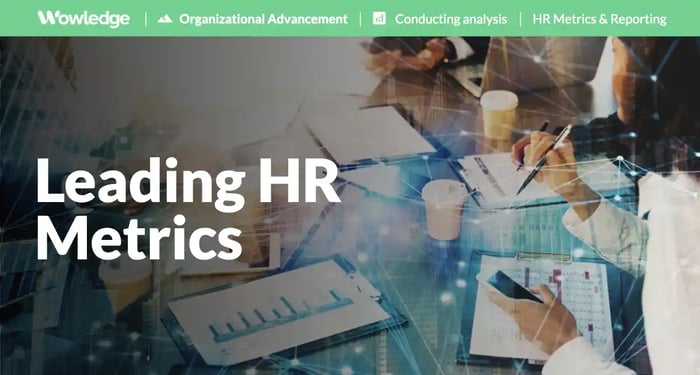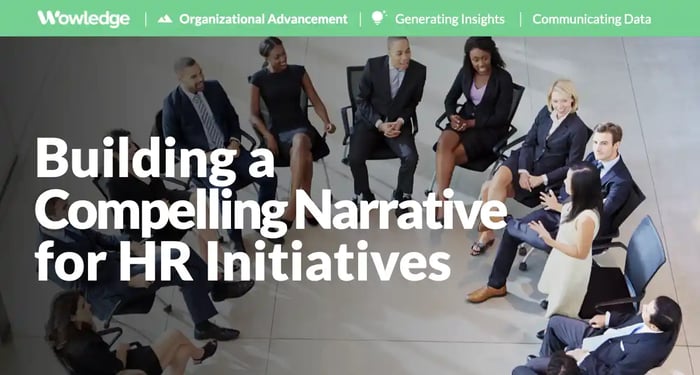Table of Contents
- What is an “HR Data culture” and its benefits?
- What are the best ways to build a Human Resources data-driven culture?
- 1. Foster commitment from leadership
- 2. Promote data-driven decision-making
- 3. Educate and train on data literacy
- 4. Facilitate access to data
- 5. Develop data governance
- 6. Produce metrics and KPIs
- 7. Be transparent and communicate
- 8. Encourage continuous improvement
- 9. Incorporate analytics tools
- 10. Establish recognition and rewards
- 11. Stay current
- 12. Create cultural alignment
- Key applications of an HR data-driven culture
- Relevant data analytics skill sets of HR Analytics teams
- Leverage change management strategies
- Relevant Practices & Tools
- FAQs
A data-driven culture has emerged as ever more critical to drive informed decision-making across various domains, and Human Resources (HR) is no exception. HR plays a strategic role in shaping an organization's success by attracting, retaining, and developing talent. A data-driven approach in HR leverages the power of analytics, providing insights into employee performance, engagement, recruitment, and overall organizational health. Such a culture harnesses the wealth of data available within an organization to make evidence-based decisions, leading to enhanced operational efficiency, improved employee satisfaction, and ultimately, a competitive edge in the ever-evolving global marketplace. In this pursuit, an HR data-driven culture is indispensable, offering precise, actionable insights that enable organizations to align their human capital strategies with overarching business objectives, fostering growth, innovation, and sustainable success.
What is interesting, is that after all the years of promoting the need to leverage the massive quantities of data that HR processes generate for useful business and talent insights, the general observation is that most HR teams lag on this front. For example, according to a report by LinkedIn, only 22% of companies have adopted HR analytics in the way it defines this capability. Similarly, Deloitte found that only 8% of companies have usable data; only 9% believe they have a good understanding of which talent dimensions drive performance in their organizations; and only 15% have broadly deployed HR and talent scorecards for line managers. Many of the challenges (and the strategies to overcome those) are quite common across organizations of all sizes. An HR data-driven culture is required to overcome circumstances such as these.
What is an “HR Data culture” and its benefits?
An HR data-driven culture is the systemic adoption and incorporation of the use of HR and business data to inform decisions about all aspects of people strategies, practices, policies, and programs. It involves the uniform use of targeted analytics to understand, evaluate, and create solutions to identified opportunities, challenges, and shortcomings in the oversight and management of people and their work. It is primarily seen in an everyday reliance on data and analyses when making decisions and judgments about workplace and workforce trends, issues, and their resolution.
Creating this type of culture offers numerous benefits to organizations by leveraging data-driven insights to inform decision-making, enhance employee experiences, and drive overall business success. Here are some key advantages:
- Supports decision-making. Data-driven HR practices enable informed decisions based on objective insights. This leads to better hiring choices, improved talent management, and more effective resource allocation.
- Aligns business objectives. An HR data-driven culture ensures HR strategies align with overall business goals. This synergy improves the overall effectiveness of the organization. The very reliance on more objective insights signals to the business leadership that HR is run as professionally as its peer functions.
- Improves strategic workforce planning. An HR data-driven culture allows organizations to predict future talent needs and plan accordingly. This helps address skill gaps, better informs succession planning, and ensures the right talent is available when needed.
- Optimizes recruitment. Data-driven HR helps identify the most effective recruitment sources, candidate profiles, and hiring strategies, leading to higher-quality hires and reduced times-to-fill.
- Enhances employee engagement. Data insights can be used to understand employee sentiments, needs, and preferences. This facilitates the design of targeted engagement programs, leading to higher job satisfaction and reduced turnover.
- Creates more accurate performance management. Data-driven performance evaluations provide a more accurate view of employee contributions. This aids in setting meaningful goals, providing constructive feedback, and linking performance to rewards.
- Amplifies learning and development. An HR data-driven culture helps identify skill gaps, training needs, and areas for professional development. This ensures employees receive relevant training, leading to increased job success and productivity.
- Informs workforce diversity and inclusion. Data can be used to monitor and improve diversity and inclusion initiatives, ensuring a more equitable workplace that values different perspectives and backgrounds.
- Creates cost efficiencies. By analyzing HR metrics, organizations can identify areas where costs can be reduced while maintaining or improving performance, leading to more efficient resource allocation.
- Increases legal compliance. A data-driven approach helps HR departments stay compliant with labor laws and regulations by tracking and documenting relevant data.
- Augments agility and innovation. With real-time data, HR can quickly respond to changing business needs, market trends, and workforce dynamics. This agility is crucial in a rapidly evolving business environment.
- Identifies issues proactively. HR data-driven can highlight potential issues early, allowing HR to address them before they escalate into significant problems.
- Measures impact. A data-driven HR culture allows you to measure the impact of HR initiatives, demonstrating the value HR brings to the organization and facilitating continuous improvement.
Overall, an HR data-driven culture creates a more efficient, effective, and responsive HR function that contributes directly to organizational success while prioritizing the well-being and growth of employees. It creates an environment that depends on objective data and facts to better understand what issues are creating barriers to success, the opportunities to overcome those barriers, and the extent to which strategies to improve outcomes have been successful.

What are the best ways to build a Human Resources data-driven culture?
Building a strong Human Resources (HR) data-driven culture is essential for making informed decisions, improving processes, and maximizing the value of the workforce. Here are some key strategies to help establish a robust HR data-driven culture:
1. Foster commitment from leadership
Begin by securing buy-in from top-level leadership. Engage top leadership to demonstrate a commitment to data-driven HR practices and emphasize the importance of using data to drive decisions. Generate support for the building and growth of HR analytics and reporting capabilities through the planning and budgeting processes.
2. Promote data-driven decision-making
Encourage HR professionals to use data when making decisions. Require the presentation of evidence and business cases for any proposed changes or introductions of new policies, practices, and programs. Bring data and analyses to line management regularly to drive conversations related to the issues, challenges, and potential solution sets. Insist on actions and follow-ups to drive responsibility for the active and proper use of reporting.
3. Educate and train on data literacy
Provide training to HR staff on data literacy, analytics tools, and best practices for data-driven decision-making. Develop and assign projects that require the use of available data, analysis, and reporting tools to help bridge any knowledge gaps and build confidence in working with data. Train line managers on the availability and use of insights generated on their behalf, and provide reports, benchmarks, and analyses that help them better manage their teams.
4. Facilitate access to data
Ensure that HR teams and their members have ready access to relevant and accurate data. This requires integrating HR systems and collaborating with IT to create unified and easily accessible data sources and reporting mechanisms. Provide line managers with regular reports and tools to enable their viewing of analytics that are useful and relevant to their daily work.
5. Develop data governance
Implement data governance policies to maintain data quality, privacy, and security. Establish guidelines for data collection, storage, and usage to ensure consistency and compliance. Create audit processes for the management of all HR and business data. Identify an owner of the processes and outputs.
6. Produce metrics and KPIs
Define clear HR metrics and Key Performance Indicators (KPIs) that align with organizational goals. Regularly track and analyze these metrics to assess the people's performance and contributions of employees, managers, and organizations. Link those as frequently as possible to selected business outcomes.
7. Be transparent and communicate
Foster a culture of transparency and collaboration around HR analytics. Encourage open discussions about data, its interpretation, and its impact on business and HR strategies. Engage managers in regular meetings with relevant insights and trends that impact business goals and objectives.
8. Encourage continuous improvement
Encourage a mindset of continuous improvement. Analyze the outcomes of HR initiatives, learn from successes and failures, and adjust strategies based on data insights. An evaluation mindset should become a key HR contribution to the businesses and managers supported.
9. Incorporate analytics tools
Leverage HR analytics tools and software to streamline data analysis. These tools can provide deeper insights and enable more efficient decision-making. Provide access to a range of tools for the collection, processing, analysis, presentation, and dissemination of vital insights for decision support.
10. Establish recognition and rewards
Recognize and reward employees and teams that effectively use data to improve business operations and HR processes to contribute to organizational success. Reinforce the successful use cases by promoting them and their success.
11. Stay current
Keep up with advancements in HR technology and data analytics. As the field and technologies are continuously evolving, stay current to ensure the organization is leveraging the latest tools and methodologies.
12. Create cultural alignment
Integrate data-driven HR practices into the broader organizational requirements for the same - think of the requirements to use financial, sales, marketing, operational, and other data in decision-making. This alignment ensures that data is valued and integrated across departments. Identify high-impact opportunities to leverage and expand the use of HR analytics.

Key applications of an HR data-driven culture
Finding a starting point is relatively easy, as the most common applications/use cases involve HR processes. Those are largely driven by the availability and broad use of automated systems that generate reporting. A Deloitte report indicates that recruiting remains the number one area of focus, followed by performance measurement, compensation, workforce planning, and retention. After that, specialized systems such as learning management (LMS) provide information on course utilization rates and completions, and employee engagement survey applications assess employee satisfaction, alignment with corporate values, and so on. Meanwhile, many HR Information Systems generate insights into workforce composition (e.g., demographics, diversity, compensation levels, benefits selections, tenure, education attainment, among others) and deployment (function, department, location, and management).
In more advanced organizations, analytics are being applied to a much wider range of business challenges, including key employee segment mobility and retention, the impact of people (and/or targeted programs) on sales, revenues, productivity, profitability, etc. Such use cases have been found to be much more influential in the development and expansion of a data-driven HR culture by virtue of their alignment with business objectives. This includes the requirement to integrate HR, organizational, and external data to develop the most strategically meaningful insights.
In general, be prepared to leverage both quantitative and qualitative data as available. For example, when seeking to understand the root causes and potential solutions to employee turnover, mixing data from employee demographics with surveys and employee focus groups or exit interviews can provide a compelling set of understandings about the issue.
And as always, seek to answer the “right questions”. Focus the development of new metrics and analyses on the questions that come up in management discussions, staff meetings, and presentations. Think about the issues that line leaders and managers ask related to the efficacy, value, or purpose of a certain HR initiative, program, or procedure. Addressing the issues that concern managers, such as:
- Are we recruiting and hiring the best available talent? Where can we better access people with the strategically needed skills?
- What is the value of our weekly check-in meetings with employee productivity or organizational performance?
- Is there a true difference in meeting departmental goals of paying people above-market rates?
Relevant data analytics skill sets of HR Analytics teams
LinkedIn recently posted an interesting piece that laid out the range of skill sets that go into having a fully functional HR analytics capability that goes a long way towards informing the staffing profile of such a group. Skills include:
- Statistical Analysis and Data Mining (e.g., HR Analytics, Data Analytics, Data Management Statistics, Data Mining, Predictive Analysis, SAS, R, Python).
- Business Intelligence (e.g., SAP Business Objects, Tableau).
- Big Data and Machine Learning.
- Market Research and Insight Techniques (e.g., Quantitative and Qualitative Research, Market Research).
- HR software (e.g., SAP products, SAP ERP, ATS, Taleo, HRIS, Data Management, Workday, Peoplesoft).
- Data Engineering and Data Warehousing (e.g., Data Marts, Data Integration, Data Governance).
- Database Management & Software (e.g., SQL, Databases).
This skill set listing can serve as a beginning template for staffing either an internal/stand-alone HR model, a centralized/combined business function team (e.g., handles all analytics requirements across functions), or one that combines internal with external resources. In general, having internal expertise in statistical analysis, business intelligence, (relevant) HR software, and database management should be considered as minimum requirements.
Leverage change management strategies
A final consideration relates to the value of planning and managing the change that is associated with expanding an HR analytics capability. Strategic change management is a core skill for HR professionals, and as such, an effort such as this provides an opportunity for HR team members to practice applying those techniques to the syndication of such a powerful and impactful HR capability. Given the historical context of analytics as probably the weakest of all HR (individual) competencies or (organizational) capabilities, consider the build-out and broadening of the use of data and analytics in HR as a cultural evolution that will require substantial awareness, education, skill building, and acceptance as a standard.
Relevant Practices & Tools
Core HR Metrics and Reporting Practices to Establish a Robust HR Decision Support Capability. >
The structured measurement and presentation of employee and human resources process data that provides quantitative insights to drive objective and educated... more »
Developing a Company-wide Culture of Data-based HR Decision Making. >
Producing reports is only the beginning. Many large and successful companies still struggle to make use of reports during decision-making a part of the widespread fabric... more »
Deploying Advanced Statistical Methods to Better Assess and Predict Trends in HR Processes, Policies, and Programs. >
Deploying advanced methods involves moving from descriptive or basic mathematical metrics (sums, averages, percentages, medians, etc.) to more sophisticated... more »
Employing Advanced Stakeholder Engagement Techniques to Reinforce the Criticality of the Targeted Change. >
When done effectively, stakeholder engagement creates trust with the initiative team, generates honest dialogue to build support for the changes, and reduces... more »
The Process to Outcomes Translation Tool: Convert HR Strategies and Processes into Representative Metrics. >
The Process to Outcomes Translation tool is designed as a guide to creating metrics that represent HR's impact on the business. The tool provides a step-by-step... more »
FAQs
What should the first six months of building an HR data-driven culture look like?
A practical roadmap starts with a narrow, business-critical use case and a clear success metric, such as reducing regrettable attrition in a single function. Parallel tracks establish a data dictionary, standard metric definitions, and basic access protocols so early insights are credible and repeatable. Monthly reviews with business leaders confirm learning and remove blockers, while a backlog queue or report captures new business and operational questions that arise as additional analytics are added. By month six, the organization should have one proven use case, shared definitions, and a queue of next priorities informed by impact and feasibility.
What are practical steps to improve HR data quality without stalling progress?
Start by fixing the “vital few” fields that drive key metrics—employee ID, org structure, job codes, and hire and termination dates—before pursuing more time- and effort-intensive data cleansing of every field. Embed validation at capture points using forced response options and required fields, and create feedback loops so report users can flag errors for rapid correction. Reconcile systems of record on a regular cadence and publish data freshness indicators on dashboards to build trust. Document definitions and examples in a living playbook to improve quality with every cycle.
How can HR choose KPIs that matter to the business rather than “vanity” metrics?
Link each metric to a clear outcome pathway, showing how the measure is expected (or statistically demonstrated) to influence revenue, cost, risk, operational performance, or customer impact. Balance leading indicators (manager coaching frequency, internal mobility rate) with lagging outcomes (productivity per FTE, regrettable attrition among top performers). Set thresholds or targets based on historical baselines and peer benchmarks so movement can be seen on the reports. Retire metrics that do not inform important decisions, and spotlight a small “north star” set of KPIs in executive forums to focus attention.
How can organizations build data literacy among HR staff and line managers?
Design tiered learning paths: essentials for all HR staff, analyst skills for a smaller cohort, and decision-use workshops for managers. Reinforce learning with office hours, a help channel, and short “how we used data to decide X” case shares in staff meetings. Provide templated dashboards with plain-language annotations so users learn by doing, not by theory alone. Recognize teams that act on insights and document outcomes, creating social proof that data fluency advances careers.










